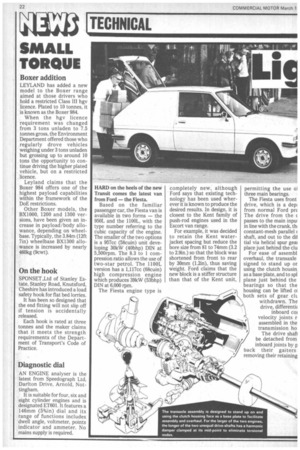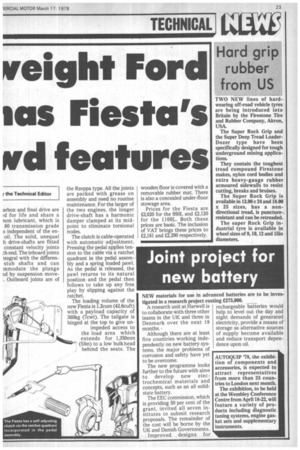HARD on the heels of the new Transit comes the latest van from Ford — the Fiesta.
Page 24

Page 25

If you've noticed an error in this article please click here to report it so we can fix it.
Based on the familiar passenger car, the Fiesta van is available in two forms — the 950L and the 1100L, with the type number referring to the cubic capacity of the engine. The smaller of the two options is a 957cc (58cuin) unit developing 30kW (40bhp) DIN at 5,500rpm. The 8.3 to 1 compression ratio allows the use of two-star petrol. The 1100L version has a 1,117cc (68cuin) high compression engine which produces 39kW (53bhp) DIN at 6,000 rpm.
The Fiesta engine type is completely new, although Ford says that existing technology has been used wherever it is known to produce the desired results. In design, it is closest to the Kent family of push-rod engines used in the Escort van range.
For example, it was decided to retain the Kent waterjacket spacing but reduce the bore size from 81 to 74mm (3.2 to 2.9in.) so that the block was shortened from front to rear by 30mm (1.2in), thus saving weight. Ford claims that the new block is a stiffer structure than that of the Kent unit, permitting the use o] three main bearings.
The Fiesta uses front drive, which is a dep. from normal Ford prz. The drive from the passes to the main inpu. in line with the crank, th, constant-mesh parallel shaft, and out to the dil tial via helical spur gem place just behind the clu For ease of assembl overhaul, the transaxle signed to stand up or using the clutch housin as a base plate, and to spl plane just behind the bearings so that the housing can be lifted a both sets of gear clt withdrawn. The drive, differentii inboard col velocity joints r assembled in the transmission ho The drive shafi be detached from inboard joints by p back their gaiters removing their retaining arbox and final drive are !d for life and share a non lubricant, which is 80 transmission grade s independent of the enoil. The solid, unequal h drive-shafts are fitted constant velocity joints ch end. The inboard joints -ttegral with the differenstub shafts and can mmodate the plunge ed by suspension move.. Outboard joints are of I the Technical Editor the Rzeppa type. All the joints are packed with grease on are packed with grease on assembly and need no routine maintenance. For the larger of the two engines, the longer drive-shaft has a harmonic damper clamped at its midpoint to eliminate torsional nodes.
The clutch is cable-operated with automatic adjustment. Pressing the pedal applies tension to the cable via a ratchet quadrant in the pedal assembly and a spring loaded pawl. As the pedal is released, the pawl returns to its natural position and the pedal then follows to take up any free play by slipping against the ratchet.
The loading volume of the new Fiesta is 1.2cum (42.6cuft) with a payload capacity of 360kg (7cwt). The tailgate is hinged at the top to give unimpeded access to the load area which Atitiza, extends for 1,350mm (53in) to a low bulk head ., behind the seats. The wooden floor is covered with a removable rubber mat. There is also a concealed under-floor stowage area.
Prices for the Fiesta are £2,020 for the 950L and £2,120 for the 1100L. Both these prices are basic. The inclusion of VAT brings these prices to £2,181 and £2,290 respectively.
























































































































